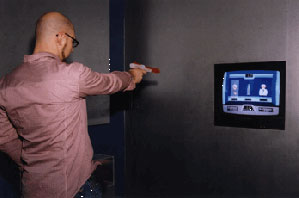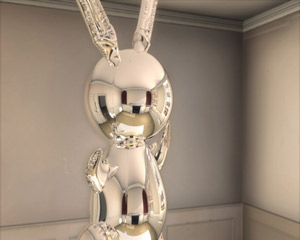Can Art Keep Up?
John Haberin New York City
Art Happens Here: Art and the Internet
New Order: Art and Technology
"Art Happens Here." The New Museum chose that title for its show about the "poetics" of the Internet, where there is no there there. Can artists find a place?
If the Internet were not bad enough, what about the things we carry and the things we encounter every step of the way? Does technology have a life of its own? Ian Cheng describes his simulation at MoMA as a "video game that plays itself." That may sound scary, at a time when AI threatens to outgrow its human overlords. Yet it looks downright absorbing and appealing, like any good game— or, for that matter, like art. It also looks back to a more comforting past, and so does "New Order."
or, for that matter, like art. It also looks back to a more comforting past, and so does "New Order."
The exhibition takes on "art and technology in the twenty-first century" with just twenty-one artists and two dozen works, all from the museum's collection. Still, these are big works, and MoMA is thinking big. It sees even AI as "mired in matter, friction, and failure," but it also counts on the artist's success. Cheng's game may play itself, but as his artistic creation. The show comes just before a summer closing to complete the museum's expansion and renovation—its second in barely fifteen years. New media have become newer, but old dreams and old pressures, from the creative act to real estate, remain.
The two shows may focus on different aspects of technology, the Internet and AI, but they see them much the same way. Both couch the virtual world in terms of clunky materials and an artist's choices. They make it hard to know just who is invading your privacy, big data or a big museum. Both also avoid a larger survey, of the history of computing or the cutting edge. In a time of virtual reality, their mind games and devices look downright dated, but that may say something, too. They take for granted that new media are no longer a small corner of the art scene and no longer new.
Dated and undone
At his death late last year, James Billington could look back on his directing the Library of Congress, which he pushed to catalog its collections and to bring them free online. He could also remember the criticism when he resigned, for how much remained dated and undone. Can a digital archive ever be up-to-date when the medium itself is so quickly outmoded? And what of digital art in an analog city? With its Net Art Anthology, Rhizome.com has undertaken a two-year display of roughly a hundred works, with a selection at the New Museum as "Art Happens Here." With luck, they will still be legible and functional by the show's end.
Events have a way of overtaking the best of us—and not just virtual reality. Wolfgang Staehle fills a wall with a panorama of Lower Manhattan and the Brooklyn Bridge that would take anyone's away. One might well overlook the rising cloud at right. Staehle had not planned on capturing the collapse of the Twin Towers. Still, one can hardly overlook the 2001 technology that causes a shift in tonal values halfway across, a shift more obvious than the cloud. Video art, computer-assisted art, and computer-generated art keep changing, and they also keep upstaging what they mean to preserve.
Some artists stick to their resolution and give in to what they cannot control. Staehle also compiles a sordid history of slave labor—and who cares if it displays in white type on a black screen right out of the forerunners of MS-DOS? Brian Mackern compiles a Net Latino Database, and so what if visitors must rely on paper printouts? That way, at least, they will have something to recall. Aleksandra Domanović even conceives of her thousand-page pdfs stacked on the museum floor as monuments. Morehshin Allahyari has monuments in mind from the start when she uses 3D printing to replicate in miniature and in resin the totems that ISIS has destroyed.
ISIS notwithstanding, the time line for becoming an ancient civilization has sped up considerably. Last year, too, MoMA's "Thinking Machines" celebrated the role of artists and designers in creating today's personal computers. It ended up as the biography of many a museum-goer. Bogosi Sekhukhuni has in mind a family portrait as well. His two channels alternate between him and his long-absent father, as they try to find common ground. Facing the viewer, they might as well be talking past one another. Come to think of it, one might say the same about no end of digital media.
Others love old equipment for just how preposterous it has become. Auriea Harvey and Michaël Samyn (as Entropy8Zuper) even envision their project as digital love letters. Alexei Shulgin poses a desktop computer running Windows 3 beneath a beach umbrella as "the world's first cyberpunk rock band"—while its equally clunky monitor sings classic rock in a dreadful monotone. Naturally its repertoire includes "Yesterday." Olia Lialina projects Web pages that no longer exist. Her browser, if this still rings a bell, is Netscape.
Some have a political point to make. Miao Ying blacks out words in a dictionary that China has censored on the Web, while Shu Lea Cheang sees online trading in garlic as a (yeah, right) "post-capitalist future." One might do better, though, to focus on a more treacherous present. I recognized only Cory Arcangel and Lynn Hershman Leeson among the many less familiar names—in a show that skips right past Stan VanDerBeek, Nam June Paik, and other digital pioneers. Mark Tribe wraps things up with a cutting-edge interface for Rhizome's listserve archives. Never mind that he calls it Starrynight after Vincent van Gogh.
Our human overlords
If the Modern wants to claim a role for itself in the new century and, Refik Anadol might say, AI, now is the time. And "New Order" necessarily boils down to new acquisitions, given the pace of art and technology since Harold Cohen and AARON in AI. A single series from the last century, by Louise Bourgeois, finds her keeping up with change long after Bourgeois in painting and well into her eighties. It also extends her way of turning sculpture into dark spaces for living. Ghostly red holograms show bestial feet in bed and empty chairs under bell jars, like a science experiment gone terribly awry. One can waltz through the exhibition as one huge, creepy installation at that, but it turns on details, including each artist's materials and back story.
Both add to the creeps, like "Refigured" at the Whitney, but both often look back as well. For Ian Cheng, the story unfolds in a distant paradise—and not on a smartphone, as with Meg Lipke, but on the large screen of good old-fashioned cinema. As its colors deepen, it may show a radioactive landscape and a fall from Eden, but it is, rest assured, of "infinite duration." Come to think of it, you can hardly lose a game that plays itself, even if you also cannot win. Besides, it is only a fantasy. The curator, Michelle Kuo, speaks of the "uneasy coexistence of intelligent networks and dumb stuff, high tech and raw material, the fabricated and the readymade," but art here is about memory and desire.
 Thomas Ruff seeks a digital equivalent to the photograms of Man Ray and Surrealism, while Mark Leckey in turn transfers his video to film—shiny close-ups of a Jeff Koons bunny that draw it and the room closer to abstraction. Luna sure sounds space age, but Leslie Thornton bases her large video on a parachute jump that opened at Coney Island in 1939. Even high tech can take on the patina of nostalgia, at least when it dates from the 1950s. Rodney McMillian fashions a cratered landscape from black vinyl, while Seth Price treasures a Vintage Bomber (meaning a bomber jacket), in vacuum-formed PVC. They all want to say just one word to you, plastics.
Thomas Ruff seeks a digital equivalent to the photograms of Man Ray and Surrealism, while Mark Leckey in turn transfers his video to film—shiny close-ups of a Jeff Koons bunny that draw it and the room closer to abstraction. Luna sure sounds space age, but Leslie Thornton bases her large video on a parachute jump that opened at Coney Island in 1939. Even high tech can take on the patina of nostalgia, at least when it dates from the 1950s. Rodney McMillian fashions a cratered landscape from black vinyl, while Seth Price treasures a Vintage Bomber (meaning a bomber jacket), in vacuum-formed PVC. They all want to say just one word to you, plastics.
The show has its share of "dumb stuff" and dark matter, but then so does art. Camille Henrot covers found objects in sand and tar, daring one to recognize the low-tech everyday beneath the blackness. Anicka Yi sets out black boxes, like a remake of Donald Judd in Plexiglas and LEDs—lined with green gel that, over time, will take on veins of blood red. Wade Guyton has his black fusion of Minimalism and technology, too, with a screen print on plywood. Tauba Auerbach has a cleaner and brighter fusion in 3D printing. Other 3D prints, by Neri Oxman and her Mediated Matter Group, could serve as bad modern sculpture or salad bowls.
Is it a mistake to focus so narrowly on matter apart from politics and meaning? Reconnaissance planes provide footage for Harun Farocki, and Trevor Paglen plays on facial recognition, but the surveillance state seems mostly left behind. Basim Magdy worked in 2012, in Egypt, and his slide show of industrial demolition may stand for the collapse of the Arab spring—or not. Jacoby Satterwhite opens his Country Ball with what looks like the Tower of Babel for Pieter Bruegel, and he ends with the splayed body of "the damned," but just what went wrong aside from loud music and dirty dancing? As so often, women have a more acute awareness, with an elusive inkjet portrait by Rosemarie Trockel and the image of an embryo by Josephine Pryde, as It's Not My Body.
"New Order" has to evoke sci-fi dystopias along with the English rock band, but here our new overlords are the artists. For Tabor Robak, a computer's calendar has taken over plans for a life, but guess who fills in the dates? Sondra Perry invites you to get in a workout, with a rowing machine and stationary bicycle, but you will be rowing across her simulated ocean, and the trainer will be her avatar. Museums may be our new overlords, too. One exits a show upstairs of affordable design on the way to the gift shop, and here one enters to an extension of the cafeteria. Slurpies by Josh Kline may hold such combinations as Coke Zero, octopus ink, and Raid, but overlords are not often forgiving.

"Art Happens Here" ran at the New Museum through May 26, 2019, "New Order" at The Museum of Modern Art through June 15. Related reviews have looked often at new media, including the birth of television, early video art, the design of personal computers, and interactive art.




